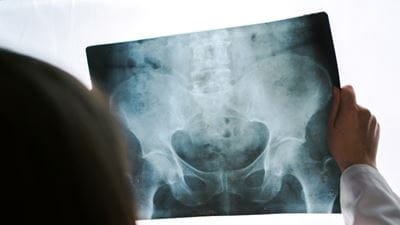Why Al Roker’s Recovery Shows Us It’s all About Getting Hip-Healthy
Al Roker, one of America’s most beloved meteorologists and co-host of the “Today” show, recently gave us a glimpse of what’s involved in a total hip replacement surgery. From his successful surgery to being up and walking a day later, Roker demonstrates the advancements in joint replacements.
If you live with hip joint pain, you also may be wondering if this procedure is right for you. Here are some preventive steps you can take to prolong your joints and recommendations on when to discuss a hip replacement with your doctor.
Total Hip Replacement and Osteoarthritis
Roker is now among the 350,000 Americans each year who undergo a total hip replacement. Joint replacements have become one of the most common elective surgeries, as well as one of the most successful orthopedic procedures performed today. Most people who have hip replacement surgery are between ages 50 and 80, but with advances in surgical techniques and the durability of the implant, both younger and older patients can benefit from the procedure.
Most often, the reason for a hip replacement is osteoarthritis, a degenerative disease where the cartilage between joints breaks down and wears away, causing swelling, pain and stiffness. Severe osteoarthritis in the hip can reduce the joint’s range of motion, making it difficult to walk. These debilitating symptoms greatly affect a patient’s quality of life.
While there are instances when a hip replacement may be unavoidable — for example, because of genetics, osteonecrosis or trauma, such as a hip fracture — there are several healthy-hip steps you can take to prolong your joint and avoid surgery.
5 Healthy-Hip Steps that Prolong Your Joints
Most orthopedic specialists view total hip replacement surgery as a last resort. The focus instead is to prolong the hip joint as much as possible with conservative measures and lifestyle changes, such as:
Lose weight. Carrying around extra weight increases pain in arthritic joints. The force you place on your joints can be up to six times your weight, and cartilage can only withstand a certain load before it starts to break down. Shedding even 10 pounds can reduce pressure and decrease the risk of painful arthritis. But don't jump into a drastic diet plan. Instead, work with your doctor and a dietitian to take healthy steps toward weight loss.
Move more. Though it may seem counterintuitive when living with painful joints, moderate exercise is suggested — not rest. Moderate movement can reduce joint pain and stiffness, while increasing flexibility, muscle strength, cardiac fitness and endurance. It also helps with weight reduction and contributes to an improved sense of well-being.
flexibility, muscle strength, cardiac fitness and endurance. It also helps with weight reduction and contributes to an improved sense of well-being.
It is important to focus on the all-important “core” — the muscles around your back and hips. When these muscles are strengthened, they are able to absorb more pressure so the hips are more supported and aligned.
Recent studies showed that people who participated in an exercise program for one hour at least twice a week for 12 weeks were 44% less likely to need hip replacement surgery six years later compared with a similar group of people who did not exercise.
Adjust activities. Modifying your current activities is a great way to avoid continued damage to your hip joints. A general rule of thumb? If it hurts, don’t do it. High-impact activities that cause pounding on the joint can contribute to increasing pain and the progression of arthritis.
Consider offloading the impact on your joints with lower-impact activities such as swimming, cycling or rowing. If you are an avid runner, consider reducing your mileage and taking advantage of options like the elliptical trainer.
Increase strength and flexibility. Working with a physical therapist to target strengthening and flexibility also may help delay the need for joint replacement surgery. Physical therapists can teach you exercises that help relieve joint pain.
The gluteal muscles in the buttocks and flexors in the pelvis are important for hip strength and flexibility. Physical therapists may design an exercise program that includes a number of different leg lifts, such as hip extensions, before progressing to exercises on weight machines.
Meet with a specialist. The earlier your hip pain is addressed by a specialist, the better. Talk to your primary care physician if your hip pain is intense or a consistent, nagging issue, and ask for a referral to an orthopedic surgeon or hip specialist. A specialist will be able to review your clinical history and any X-rays or MRIs to properly diagnose and determine a plan of care.
For intermittent pain management, a specialist may recommend non-steroidal anti-inflammatory drugs or NSAIDs to help relieve arthritis pain. Steroid injections, like cortisone, that reduce joint inflammation may be recommended to offer short-term relief.
Making the Call for Surgery
If after many of these approaches, your pain continues to diminish your function and affects areas of life you previously found enjoyable, then surgery may be the best option.
The decision to have total hip replacement surgery is very individualized. Having a two-way dialogue with your doctor about your clinical history, pain levels, quality of life, and the risks and benefits of surgery will help you determine whether to proceed with a replacement.
Even if you eventually need a joint replacement, taking these hip-healthy steps now to lose weight and strengthen muscles around your joints will help you later on your road to recovery and regaining activities that bring you joy.
Learn More About Orlando Health Joint Replacement Surgery
What is robotic-arm assisted joint replacement surgery, and why is it better than other types of surgery for knee or hip replacement? Download our free guide to learn more about this minimally invasive surgery.
Learn More










